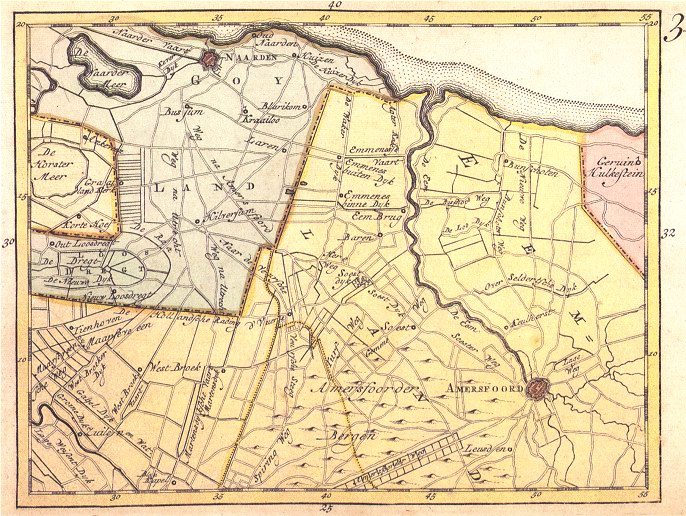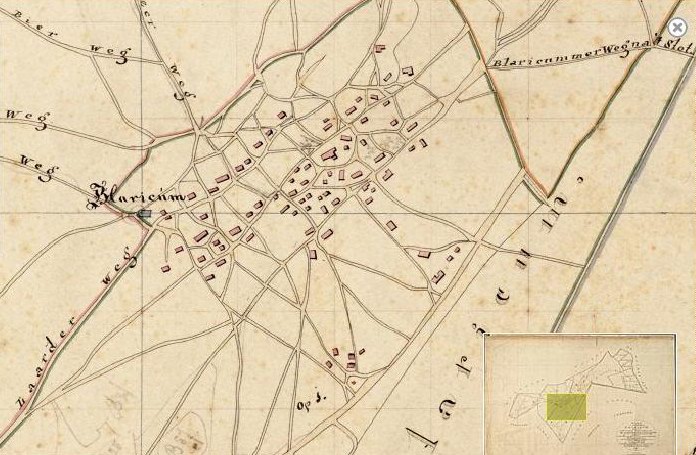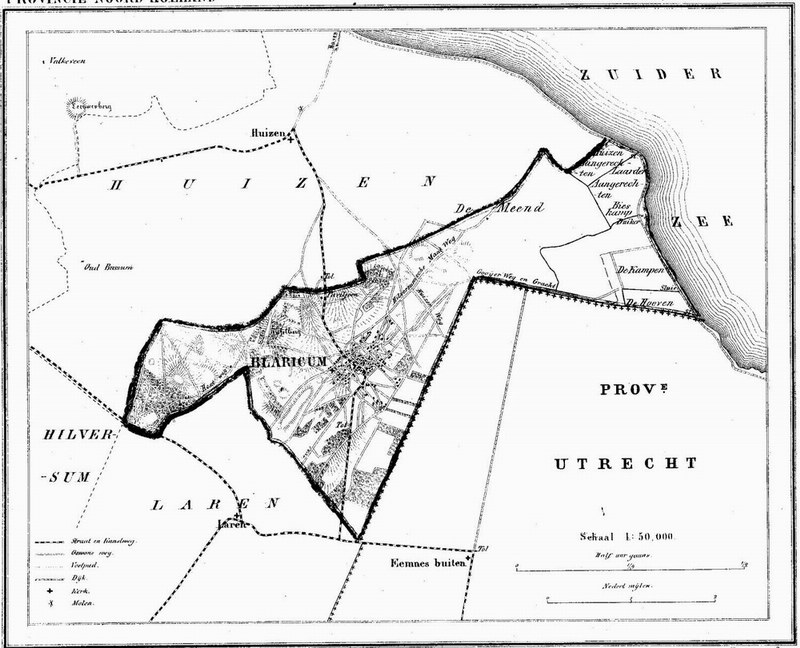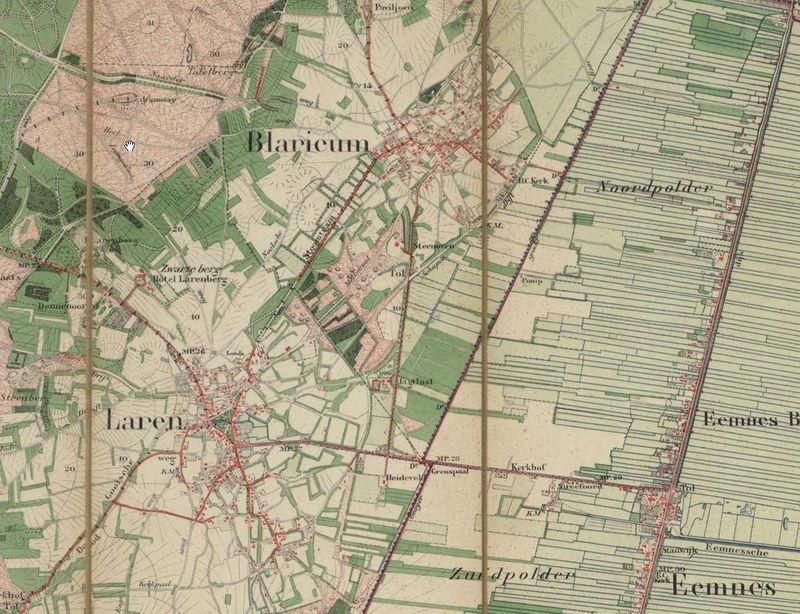.
History of the Gooi
968
At that time, the Gooi was called Naerdiclant or Nardingerland. The name derives from a small settlement situated on what is now the Zuiderzee. This settlement was located slightly further north than present-day Oud-Naarden.
Count Wichman II of Hameland granted Nardingerland to his daughter Luitgarde. He had founded a monastery for her on the Elterberg near Emmerich, and she became the first abbess there. This grant was confirmed by Emperor Otto I on June 29, 968.
1260-1300
Nardingerland remained under the authority of the abbesses of Elten for about 300 years, but their possessions were increasingly threatened by others. The Bishop of Utrecht supported those who wanted to move from the lands along the Eem River, while the Counts of Holland also laid claim to the area. In 1280, Count Floris V of Holland won the battle and forced Abbess Godelinde to transfer almost all rights to him in exchange for a sum of money and a perpetual lease.
In 1285, Floris V overthrew the Lord of Aemstel, but was himself murdered near Muiderberg in 1296. From that time on, the name Gooiland came into use.
1350
On May 15, 1350, a band of Sticht raiders invaded Gooiland, and Naarden was plundered and burned down (the Hook and Cod Wars). By order of Count William V, a new site was designated for the city to be rebuilt. This site was further south, towards the Gooi hills, and offered better protection from the Zuiderzee.
1400-1500
The name "erfgooier" (literally "erfgooier") appears early on. In 1404, the first letter of agreement was issued and confirmed by Duke Albert of Bavaria.
In the 15th century, over 5,000 people lived in Gooiland, about half of whom lived in Naarden. Sheep were herded on the heaths, and rye and barley were grown in the fields surrounding the villages. Naarden had many cloth mills; the wool was spun in the Gooi villages.
However, disputes between Holland and the Sticht (Utrecht) were frequent. At the end of the century, Gooiland also suffered from raids by Gelderlanders.
In 1420-1422, war broke out between Holland and the Sticht, and Naarden was attacked. However, the city had by then been sufficiently fortified that the attack was repelled.
In 1481, Naarden was attacked again by the Sticht, which resulted in deaths and the city was plundered. 1567
Resistance against the Spanish King Philip II, then lord of the Netherlands, grew. After the Beeldenstorm in 1566, the king sent the Duke of Alva with a large army. Gooiland was still peaceful at that time.
Note: The Beeldenstorm was a large-scale destruction of statues of saints and other objects from Catholic religious sites by Protestants.
Note: The Beeldenstorm was a large-scale destruction of statues of saints and other objects from Catholic religious sites by Protestants.
1572
In December of that year, Naarden was massacred and destroyed by the Spanish.
In surrounding villages such as Blaricum, things remained relatively quiet.
1609
Pieter Corneliszoon Hooft became bailiff of Gooiland and moved into the castle in Muiden.
1672
That year, the French invaded the Dutch Republic. On June 10, Naarden surrendered without resistance, and the city remained under French rule until September 1673, when Prince William III recaptured it. Shortly thereafter, the fortifications were renewed with the double ramparts, which still exist today.
1773
Map of the province of Utrecht with Gooiland in the upper left

1787
There was growing resistance from the Patriots to the rule of Prince William V. His wife Wilhelmina called upon her brother, King Friedrich Wilhelm II of Prussia, for help. He sent an army of 20,000 men, which occupied Naarden.
1795
The French reached the Gooi region in January and were greeted as liberators.
1812-1814
Under the French occupation, things were bad. Nothing remained of industry. After Napoleon's defeat at Leipzig in 1813, the main fortresses in the Netherlands were declared under siege. In May 1814, the French were defeated.
During those war years, small villages like Blaricum and Laren suffered greatly from looting and destruction. They were unable to develop, and agriculture and livestock farming provided only a meager living. Until well into the 19th century, Gooiland was considered a remote area. Passenger transport from Amsterdam and Utrecht was possible by stagecoach. Freight transport was provided by the barge from Naarden to Amsterdam.
Below is the cadastral map of Blaricum around this time.

Map of Blaricum ca. 1860

1874
The Gooi region emerged from its isolation with the official opening of the Oosterspoorweg (Eastern Railway) on July 10, 1874. In 1882, the Amsterdam-Naarden-Laren tram line followed, and from there, lines to Hilversum, Blaricum, and Huizen.
This brought major changes to the region. The Gooi became accessible and transformed from a relatively unknown rural area into an area where many city dwellers settled in large homes surrounded by beautiful nature. When the railway opened, 20,000 people lived in the Gooi. By 1900, that number had doubled, mainly due to the growth of Hilversum and Bussum.
Map from around 1900 showing the route of
the Gooische Stoomtram (Gooi Steam Tram) and the toll at the Eemnesserweg.

Blaricum
Until the end of the 18th century, Blaricum belonged judicially to Laren, although the village had had its own administration since time immemorial. In 1795, the separation from Laren was complete. Both were agricultural villages, but weaving was also practiced there in the past.
Towards the end of the 18th century, Laren had approximately 50 to 60 weaving mills, and Blaricum about 20. A century later, these had disappeared in Blaricum, while only 9 weaving mills remained in Laren. Agriculture and livestock farming were then the only sources of income.
In the twentieth century, the population increased rapidly. Many from outside the village settled there, thus creating a villa village. Fortunately, however, the core of the old village remained untouched and retained its rural character.
